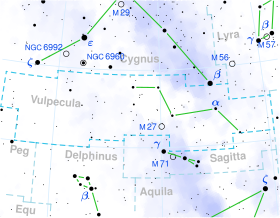
Summary
9 Vulpeculae is a star in the northern constellation of Vulpecula, located about 560 light years away based on parallax. It is visible to the naked eye as a faint, blue-white hued star with a baseline apparent visual magnitude of 5.01. The star is moving further from the Earth with a heliocentric radial velocity of +5 km/s.
| Observation data Epoch J2000 Equinox J2000 | |
|---|---|
| Constellation | Vulpecula |
| Right ascension | 19h 34m 34.89705s[1] |
| Declination | 19° 46′ 24.2423″[1] |
| Apparent magnitude (V) | 5.010±0.009[2] (4.99 - 5.08)[3] |
| Characteristics | |
| Spectral type | B8 IIIn[4] |
| Apparent magnitude (U) | 4.499±0.012[2] |
| Apparent magnitude (B) | 4.906±0.011[2] |
| Variable type | suspected[3] |
| Astrometry | |
| Radial velocity (Rv) | +5.00[5] km/s |
| Proper motion (μ) | RA: +13.148[1] mas/yr Dec.: +5.142[1] mas/yr |
| Parallax (π) | 5.8317 ± 0.1242 mas[1] |
| Distance | 560 ± 10 ly (171 ± 4 pc) |
| Absolute magnitude (MV) | −1.14[6] |
| Details | |
| Mass | 3.5[7] M☉ |
| Radius | 2.8[8] R☉ |
| Luminosity | 216[8] L☉ |
| Surface gravity (log g) | 3,54[7] cgs |
| Temperature | 12,042[7] K |
| Metallicity [Fe/H] | −0.03[7] dex |
| Rotational velocity (v sin i) | 185[9] km/s |
| Age | 185[10] Myr |
| Other designations | |
| Database references | |
| SIMBAD | data |
This a B-type star with a stellar classification of B8 IIIn,[4] where the 'n' notation indicates "nebulous" lines due to rapid rotation. It has a high rate of spin with a projected rotational velocity of 185 km/s.[9] The star is radiating 216 times the Sun's luminosity from its photosphere at an effective temperature of 12,042 K. This is a suspected variable star of unknown type, ranging in magnitude from 4.99 down to 5.08.[3]
9 Vulpeculae has two reported companions: component B, with a separation of 9.3" and magnitude 13.4, and C, with a separation of 108" and a magnitude of 12.5".[12][4] Both are unrelated background objects.[13][14]
References edit
- ^ a b c d e Vallenari, A.; et al. (Gaia collaboration) (2023). "Gaia Data Release 3. Summary of the content and survey properties". Astronomy and Astrophysics. 674: A1. arXiv:2208.00211. Bibcode:2023A&A...674A...1G. doi:10.1051/0004-6361/202243940. S2CID 244398875. Gaia DR3 record for this source at VizieR.
- ^ a b c Harmanec, P.; et al. (2020). "A new study of the spectroscopic binary 7 Vul with a Be star primary". Astronomy and Astrophysics. 639. Table A.1. arXiv:2005.11089. Bibcode:2020A&A...639A..32H. doi:10.1051/0004-6361/202037964. S2CID 218862853.
- ^ a b c Samus, N. N.; Durlevich, O. V.; et al. (2009). "VizieR Online Data Catalog: General Catalogue of Variable Stars (Samus+ 2007-2013)". VizieR On-line Data Catalog: B/GCVS. Originally Published in: 2009yCat....102025S. 1. Bibcode:2009yCat....102025S.
- ^ a b c Mason, Brian D.; Wycoff, Gary L.; Hartkopf, William I.; Douglass, Geoffrey G.; Worley, Charles E. (2001). "The 2001 US Naval Observatory Double Star CD-ROM. I. The Washington Double Star Catalog". The Astronomical Journal. 122 (6): 3466. Bibcode:2001AJ....122.3466M. doi:10.1086/323920. Vizier catalog entry
- ^ Gontcharov, G. A. (2006). "Pulkovo Compilation of Radial Velocities for 35 495 Hipparcos stars in a common system". Astronomy Letters. 32 (11): 759–771. arXiv:1606.08053. Bibcode:2006AstL...32..759G. doi:10.1134/S1063773706110065. S2CID 119231169.
- ^ Anderson, E.; Francis, Ch. (2012). "XHIP: An extended hipparcos compilation". Astronomy Letters. 38 (5): 331. arXiv:1108.4971. Bibcode:2012AstL...38..331A. doi:10.1134/S1063773712050015. S2CID 119257644. Vizier catalog entry
- ^ a b c d Anders, F.; et al. (August 2019). "Photo-astrometric distances, extinctions, and astrophysical parameters for Gaia DR2 stars brighter than G = 18". Astronomy & Astrophysics. 628: A94. arXiv:1904.11302. Bibcode:2019A&A...628A..94A. doi:10.1051/0004-6361/201935765. ISSN 0004-6361.
- ^ a b Stassun, Keivan G.; et al. (September 2018). "The TESS Input Catalog and Candidate Target List". The Astronomical Journal. 156 (3): 102. arXiv:1706.00495. Bibcode:2018AJ....156..102S. doi:10.3847/1538-3881/aad050. ISSN 0004-6256.
- ^ a b Abt, Helmut A.; Levato, Hugo; Grosso, Monica (2002). "Rotational Velocities of B Stars". The Astrophysical Journal. 573 (1): 359–365. Bibcode:2002ApJ...573..359A. doi:10.1086/340590.
- ^ Gontcharov, G. A. (2012). "Dependence of kinematics on the age of stars in the solar neighborhood". Astronomy Letters. 38 (12): 771–782. arXiv:1606.08814. Bibcode:2012AstL...38..771G. doi:10.1134/S1063773712120031. S2CID 118345778. Vizier catalog entry
- ^ "9 Vul". SIMBAD. Centre de données astronomiques de Strasbourg. Retrieved 2019-03-14.
- ^ Dommanget, J.; Nys, O. (2002). "VizieR Online Data Catalog: CCDM (Catalog of Components of Double & Multiple stars) (Dommanget+ 2002)". VizieR On-line Data Catalog: I/274. Originally Published in: Observations et Travaux 54. 1274. Bibcode:2002yCat.1274....0D. Vizier catalog entry
- ^ Vallenari, A.; et al. (Gaia collaboration) (2023). "Gaia Data Release 3. Summary of the content and survey properties". Astronomy and Astrophysics. 674: A1. arXiv:2208.00211. Bibcode:2023A&A...674A...1G. doi:10.1051/0004-6361/202243940. S2CID 244398875. Gaia DR3 record for this source at VizieR.
- ^ Vallenari, A.; et al. (Gaia collaboration) (2023). "Gaia Data Release 3. Summary of the content and survey properties". Astronomy and Astrophysics. 674: A1. arXiv:2208.00211. Bibcode:2023A&A...674A...1G. doi:10.1051/0004-6361/202243940. S2CID 244398875. Gaia DR3 record for this source at VizieR.



